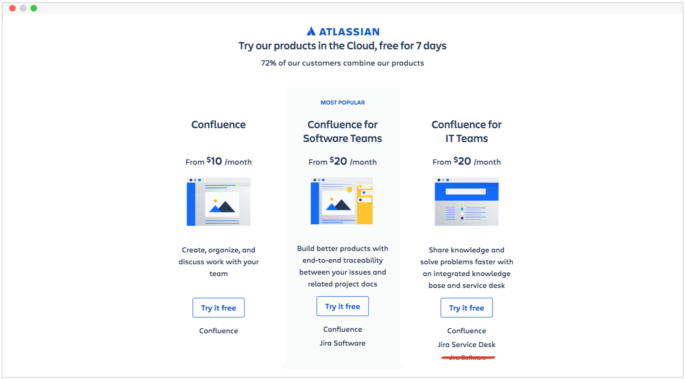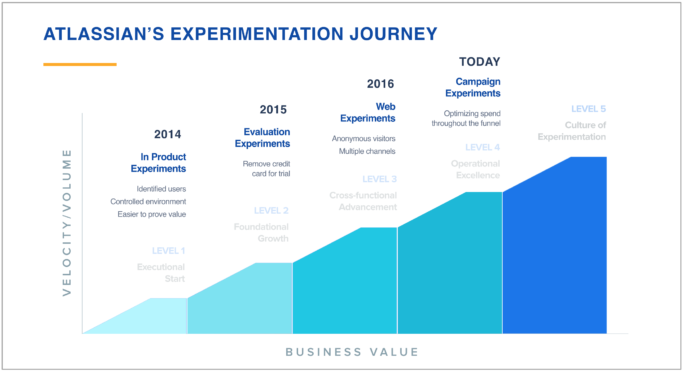“Experiments help us make our products and our user journeys better, based on being able to provide the most friction-free experience for our users. That would be very hard to do just based on intuition. We can get a lot of customer feedback, we can get a lot of qualitative feedback, and we can put in our best thinking. At the end of the day, we need to actually understand how the different changes affect our users in each step of the way. And experimentation is how we get there.”
Archana AgrawalHead of Enterprise and Cloud Marketing, Atlassian
Atlassian experiments across the customer journey
At a glance
- Atlassian runs over 25 experiments per month for marketing purposes, optimization and within their product itself
- Atlassian’s roster of more than 100k customers includes some of the largest brands and businesses in the world
Experimentation helps Atlassian optimize its customer experience
Today’s business innovators are going out of their way to meet the current needs of their consumers, and data plays an increasingly large role in fostering loyalty and revenue growth. Experimentation offers real-world feedback about the customer and drives intelligent, data-driven decision-making. One such innovator is Optimizely customer, Atlassian, a company whose mission is to change the way that teams work. The company’s suite of collaboration software – including Jira, Confluence, Stride, and Trello – is designed to help teams reach their full potential. As CMO Rob Chatwani says, “The belief here has always been that some of humanity’s most powerful advancements and innovations come from the power of great teamwork.”
Atlassian’s roster of more than 100k customers includes some of the largest brands and businesses in the world, such as Citigroup, eBay, Coca-Cola, Visa, BMW and NASA. The company has taken a product-focused path to expansion, which has resulted in phenomenal growth. Early on, they adopted a unique approach: unlike most software companies, they decided to forego a traditional salesforce, instead focusing on delivering a unique self-service experience. Marketing the product through paid search and other digital channels, Atlassian puts their software directly into the hands of users.
Optimizely helps Atlassian to experiment across all aspects of the buyer journey in order to optimize the digital experiences of all their customers. Because of this unique model, experimentation (and digital experience optimization) is critical to the company’s success and is incorporated into:
- Product discovery
- Pricing and packaging
- Onboarding
- Cross-selling and upselling
Use Case 1: Pricing and packaging experimentation
Even when results are unexpected, experimentation is key to learning and evolving. Tsao shares an example of a key hypothesis that was disproven through experimentation. “Our hypothesis was that if we bundled products together, it would be more convenient for users. We hypothesized that the more products we bundled together, the more our users could try our products and adopt [them]. What we found was that if we bundled more than two products at a time, in fact, if we bundled three products together, it actually confused users and made it harder for them to be engaged because they were spread so thin between three products. They couldn’t dive into one or two and really engage with the product and be activated. So we started dialing that back. [Now] we don’t bundle more than two products at a time. We want to keep it simple for the user.”
Atlassian found that moving from three bundling products to two led to high retention rates. Tsao adds, “The biggest impact experimentation has had on Atlassian is really allowing us to not be afraid to take risks, to innovate for our customers, and to use data to really drive those decisions. Optimizely allows us to experiment with confidence, speed, and efficiency.”

Use Case 2: Gating free trials with credit card experimentation
Tsao shares a second example of a key experiment that led to increased revenue growth. The hypothesis was to add a gated credit card form (like Netflix) before a free trial. “We started off thinking that it would make the users more qualified. If they enter a credit card then we know that you’re serious. Well, we actually had a hypothesis, “What if you removed the credit card? What would happen?” So we started to remove that credit card and we got a lot more traffic but we actually saw that it didn’t degrade the users coming through.”
The increase in traffic with no loss to conversion rate meant significant growth for Atlassian. It’s just another example of how Optimizely helps their teams move faster, make better decisions and deliver better experiences to their customers. As Tsao explains, “Experimentation gives us the data to measure what impact we’re having, and allows us to continue to learn and create a bigger and better impact on our customers.”
